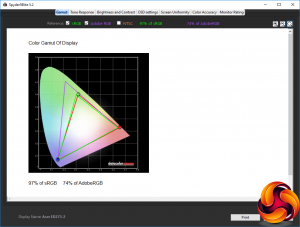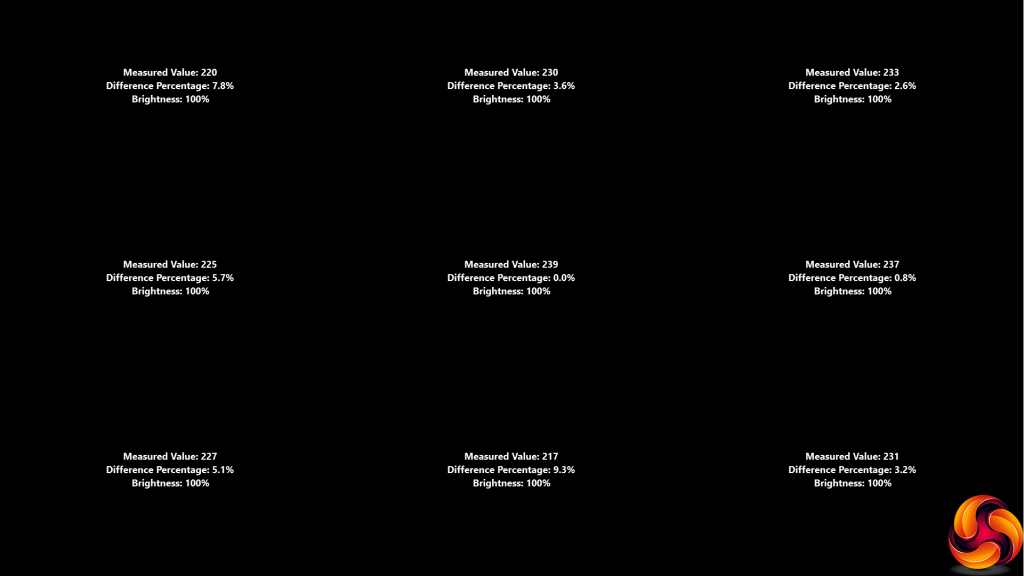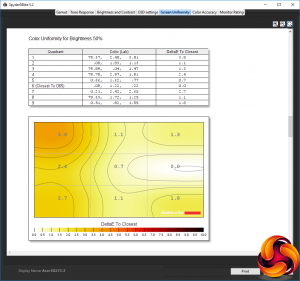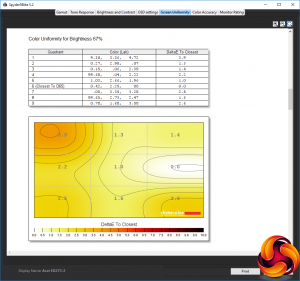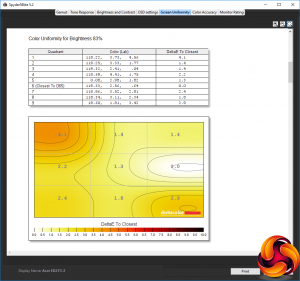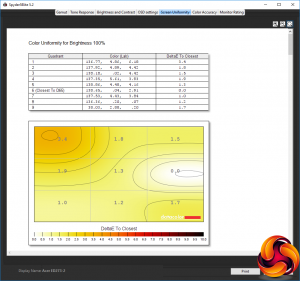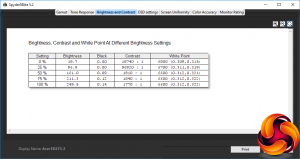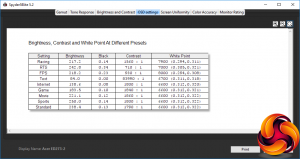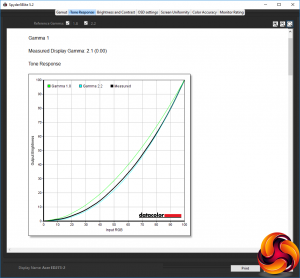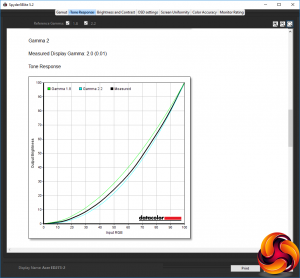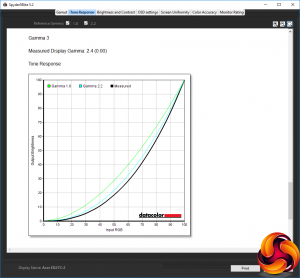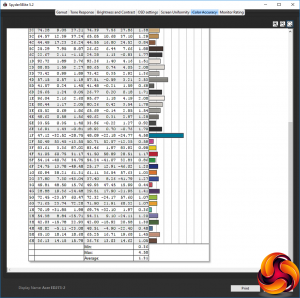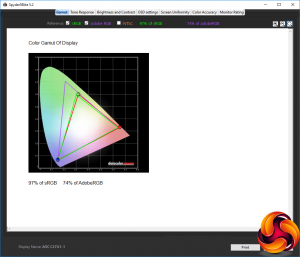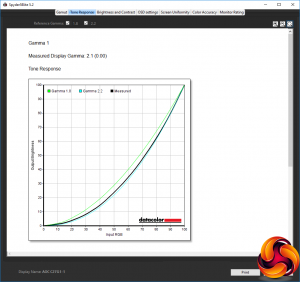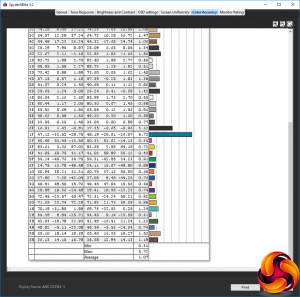Our main test involves using a DataColor Spyder Elite 5 Colorimeter to assess a display’s image quality. The device sits on top of the screen while the software generates colour tones and patterns, which it compares against predetermined values to work out how accurate the screen is.
The results show –
- A monitor’s maximum brightness in candelas or cd/m2 at various levels set in the OSD.
- A monitor’s contrast ratio at various brightness levels in the OSD.
- The brightness deviation across the panel.
- The black and white points.
- The colour accuracy, expressed as a Delta E ratio, with a result under 3 being fine for normal use, and under 2 being great for colour-accurate design work.
- The exact gamma levels, with a comparison against preset settings in the OSD.
We first run this test with the display in its default, out-of-the-box state, with all settings on default. We then calibrate the screen using the Spyder software and run the test again.
We always test the display subjectively on the Windows desktop, using it for general tasks such as browsing and word processing, and with games as well, even if the display is not intended solely for that purpose.
We pay careful attention to any artefacts, ghosting or motion blur, and enable any gaming-specific features, such as adaptive-sync settings like G-Sync or FreeSync, using a compatible graphics card in our test PC.
We performed the quality tests on the C27G1 at its native 1,920 x 1,080 resolution in the default mode, after resetting the OSD, which enables FreeSync where available. Our test system was equipped with an AMD Radeon Vega Frontier Edition graphics card, which supports FreeSync.
The gamut is not that impressive, with only 97 per cent of sRGB and 74 per cent of AdobeRGB.
Brightness uniformity isn't so bad, merely mid-range, although there is much more aberration on the left of the panel than the right, particularly the top-left corner.
Colour uniformity is even better, although again the top-left corner is the worst culprit for aberration.
The white point gets slightly warmer as the brightness increases, starting at 6800K and ending up at 6600K. Contrast values are consistently high, as we would expect from a VA panel. Note that this is with the contrast set to 50 per cent, so more is available even without DCR. This is also one panel where zero brightness does almost mean the backlight is completely off, with just 18.7cd/m2 at this setting. The 100 per cent brightness setting is virtually spot on the 250cd/m2 rating too – although this is not immensely high.
At this point we should point out again that the OSD presets are divided in two, with Games Modes on a quick menu, and the more pedestrian options in an Eco section of the main menu, under luminance.
Starting with the Games Modes, the Racing preset has reasonably high brightness and contrast of 217.2cd/m2 and 1,560:1 respectively, but a cool 7900K white point. The RTS Game Mode uses close to full brightness at 242.8cd/m2, but a much lower 710:1 contrast and warmer 7000K white point. The FPS option uses similar brightness to Racing at 218.2cd/m2, and similar cool 8000K white point, but lower 930:1 contrast.
The rest of the presets we measured were Eco modes. The Text setting takes the usual route of low brightness (84cd/m2) but very high contrast, measured as an unrealistic 83,990:1, but a mid-range 6700K white point. All the other Eco modes use a 6600K white point, and contrast around 1,800:1, but vary the brightness, with Internet using 138.6cd/m2, Game 183.5cd/m2, Movie 221.1cd/m2, and Sports the full 250cd/m2. The Standard mode operates at 238.4cd/m2, as it is set for 90 per cent brightness.
The C27G1's three gamma settings are a little strange. The default Gamma 1 corresponds to 2.1, whilst Gamma 2 is 2.0, and Gamma 3 is 2.4. We've come across this arrangement with AOC monitors before, where the gamma values are not in order of magnitude. This is also rather a narrow range.
The most impressive result for this screen is its out-of-the-box colour accuracy. With an average deviation of just 1.31, this is a very faithful monitor. But could we improve matters with a bit of adjustment?
The gamut remains as poor as it was before, with 97 per cent of sRGB and 74 per cent of AdobeRGB.
We only retested Gamma 1, which remains the same at 2.1.
However, colour accuracy improved to an even better result with calibration. The average deviation of 1.07 is one of the best results we have seen, showing the quality of the panel AOC has used in this area.
The excellent colour accuracy is the best aspect of this screen's performance. Otherwise, it is mid-range and its gamut mediocre. However, there is a good selection of presets for those who don't want to adjust things themselves, plus the three user-configurable presets for those who do.
Nevertheless this is still very much a gaming monitor, not a gaming monitor that might want to moonlight for more professional work. It was perfectly decent for the everyday tasks we tried, which included video editing. But gaming was its forte. With AMD FreeSync on hand, we found that the titles we tried – including ones that could hit close to 144fps to max out this screen's refresh – were smooth and pleasant to play.
Be sure to check out our sponsors store EKWB here
 KitGuru KitGuru.net – Tech News | Hardware News | Hardware Reviews | IOS | Mobile | Gaming | Graphics Cards
KitGuru KitGuru.net – Tech News | Hardware News | Hardware Reviews | IOS | Mobile | Gaming | Graphics Cards




